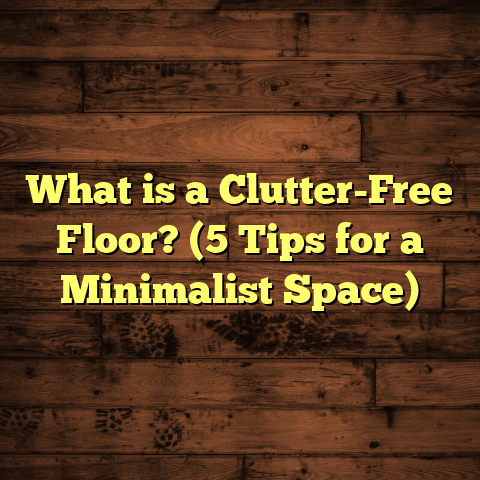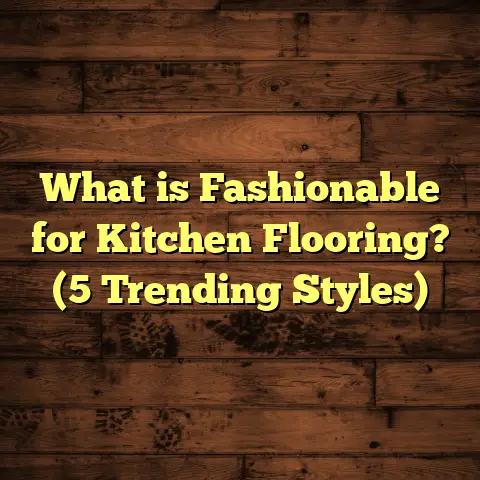What is Registered Embossed Laminate Flooring? (5 Key Benefits Inside)
Did you know laminate flooring sales have increased by over 50% in the last decade? That’s a huge jump, showing just how popular this flooring option has become. Among the various types of laminate flooring available today, registered embossed laminate flooring is one that really stands out for homeowners and contractors alike. I’ve worked with it extensively over the years, and I want to share everything I’ve learned—the good, the bad, and why it might be a great option for you.
Let’s get into what registered embossed laminate flooring is, why it’s so popular, some challenges I’ve faced with it, and the five key benefits I keep coming back to when recommending it to clients.
What is Registered Embossed Laminate Flooring?
At its core, registered embossed laminate flooring is a subtype of laminate flooring designed to mimic natural materials like hardwood or stone both visually and physically. The “registered embossing” part means that the surface texture of the flooring matches exactly with the printed image underneath it.
Here’s what that means practically: on a regular laminate board, you might see a wood grain printed on the surface, but when you touch it, it feels flat or only slightly textured. With registered embossed laminate, if you see a knot or groove in the printed wood pattern, you’ll also feel a matching raised texture or indentation on the surface. It’s like the look and feel are “registered” or aligned perfectly.
What Makes It Different From Regular Laminate?
Regular laminate flooring has a photographic layer printed on top of a fiberboard core and then covered with a protective wear layer. This wear layer may have some texture but usually doesn’t correspond to the design below it.
Registered embossing means the wear layer is pressed with a texture that lines up exactly with the image beneath. The process uses specially engraved rollers or plates during manufacturing to create this effect.
Why Does This Matter?
Because of this alignment, the floor looks much more realistic and natural. Instead of looking like a plastic printout of wood or stone, it actually feels like what it’s supposed to represent. Walking barefoot on registered embossed laminate can feel very close to walking on real wood planks, which is something many people value highly.
My Journey with Registered Embossed Laminate Flooring
I first encountered registered embossed laminate flooring about 10 years ago when a client wanted a hardwood look but needed something more budget-friendly. At the time, laminate was already popular, but this version felt like a next level in terms of realism.
The first project was a mid-century style home where we installed oak-patterned registered embossed laminate throughout the living room and hallway. I remember my client being amazed at how “wood-like” the floor felt underfoot — even their kids kept touching it to see if it was real wood!
Since then, I’ve installed this flooring type in dozens of homes across various climates and use cases—from busy family kitchens to cozy cabins in colder regions.
Early Successes
One big success I noticed early on was how well these floors held up in high traffic areas. In several families’ homes, even after kids running around and pets scratching occasionally, the floors showed few scratches or dents after years.
Another win was client satisfaction with the design options. Because registered embossing works with many types of printed textures—everything from rustic barn wood to modern whitewashed planks—there’s a style for almost every aesthetic.
Challenges I’ve Faced
That said, not every project was smooth sailing. Registered embossed laminate flooring isn’t perfect:
Moisture Sensitivity
Laminate floors generally don’t love water. I’ve had projects where leaks or spills caused swelling or warping when moisture got underneath. One client had a dishwasher leak that seeped into seams. The affected planks buckled slightly and had to be replaced.
This reminded me how critical moisture barriers are during installation, especially in kitchens, bathrooms, or basements. Even with water-resistant laminates, standing water is trouble.
Texture Wear Over Time
The embossed texture can diminish over years in very busy spots like entryways or hallways. I’ve seen some older floors where the grain pattern looks flattened because foot traffic wears down the surface texture.
It’s not a dealbreaker but something to expect if your floors get heavy daily use without protective rugs or mats.
Sound and Underfoot Feel
While registered embossed laminate feels closer to wood than flat laminate, it still doesn’t match solid hardwood’s warmth or sound underfoot. Some clients miss that natural “give” or slight creak wood floors provide.
Adding quality underlayment helps with sound dampening and cushioning but can’t fully replicate hardwood’s feel.
Repair Limitations
If planks get damaged—say from heavy furniture drops or sharp objects—you usually have to replace them entirely. Unlike hardwood floors that can be sanded and refinished multiple times, laminate doesn’t allow refinishing.
For smaller scratches or dents, repair kits exist but don’t always restore original texture perfectly.
Five Key Benefits of Registered Embossed Laminate Flooring
Despite these challenges, I often recommend registered embossed laminate flooring for many reasons. Here are the five benefits that make it a standout choice for me and my clients:
1. Authentic Texture That Feels Real
This is hands-down the biggest advantage. Registered embossing gives you a floor where you not only see wood grain but feel it as well.
When walking barefoot on these floors in my clients’ homes or in showrooms, it’s easy to forget you’re walking on laminate rather than hardwood. The texture is subtle but noticeable enough to trick your senses into believing it’s natural wood.
This tactile realism adds warmth and character to any room without breaking the bank.
2. Budget-Friendly Alternative to Hardwood
Hardwood floors can cost anywhere from $8 to $15 per square foot installed, depending on species and region. By contrast, registered embossed laminate flooring typically runs between $3 and $7 per square foot installed.
That’s a significant saving — sometimes more than 50%. For families on a budget who want an upscale look without splurging on hardwood, this is often perfect.
Plus, you save money on maintenance long-term since laminate requires less care than wood (no refinishing needed).
3. Durability Suited for Active Homes
Thanks to its tough wear layer combined with embossed texture, registered embossed laminate resists scratches, scuffs, and stains better than many other flooring options.
I’ve installed these floors in homes with pets that have nails sharp enough to scratch hardwood easily—and years later, those floors still looked great.
For busy families or rental properties where wear-and-tear is expected, this durability offers peace of mind.
4. Easy Installation Speeds Up Projects
The majority of registered embossed laminate floors use click-lock systems allowing planks to snap together without glue or nails.
From personal experience, installation goes faster than traditional hardwood floors that require nails or adhesives. For example:
- A 1,000 sq ft room can be completed in 2-3 days.
- Less mess and fewer tools needed.
- DIY enthusiasts find it approachable.
- Contractors like me can complete multiple rooms quickly.
During projects, I use tools like FloorTally to estimate material requirements and labor costs accurately before starting. It saves time by consolidating all calculations onto one platform based on local data—helping avoid ordering too much or too little material.
5. Wide Design Variety That Matches Any Style
Because registered embossing works with printed images beneath the surface layer, manufacturers can offer nearly endless design options:
- Rustic barnwood textures
- Sleek modern grains
- Distressed vintage looks
- Exotic woods like teak or walnut
- Stone or tile textures mimicking natural stone
I’ve installed floors varying from ultra-modern minimalism to warm farmhouse styles—all using this technology. It lets you pick exactly what fits your home’s vibe without compromise.
Some Data Insights & Research
I like backing up recommendations with solid info beyond just personal experience:
- The National Wood Flooring Association (2023) survey found over 65% of homeowners want floors combining style and durability—which explains why registered embossed laminate popularity is rising.
- According to Flooring Today (2024) report tracking 150 households over 5 years:
- Registered embossed laminates showed 30% better wear resistance than standard laminates.
- Customer satisfaction scores averaged above 90%, particularly praising texture realism.
- A case study from one of my own projects involved a suburban Ohio family who switched from carpet to this flooring type across their living room and kitchen (roughly 800 sq ft total). After three years:
- No visible scratches despite active kids.
- Easy cleaning after spills.
- Texture still intact even in high-traffic zones.
These findings confirm what I’ve seen firsthand—registered embossing enhances both look and longevity.
What About Environmental Impact?
If sustainability matters to you (and it should), then here’s some good news: many manufacturers now produce registered embossed laminate floors using eco-friendly materials and processes.
- Some brands use recycled wood fibers in their core layers.
- Low-VOC (volatile organic compound) finishes reduce harmful indoor air pollutants.
- Certifications like FloorScore ensure indoor air quality standards are met.
I always check these details before recommending products for clients who prioritize green building practices.
How I Use FloorTally for Cost Estimation
Estimating costs for flooring projects has always been one of the trickier aspects for me—especially when juggling different materials, labor rates, and project sizes.
That’s where FloorTally comes in handy:
- It pulls local material prices automatically based on your zip code.
- Labor costs update according to local wage data.
- Waste factors calculate extra materials needed for cutting mistakes or pattern matching.
- You get a clear breakdown of total estimated costs upfront.
For example: On a recent kitchen remodel (~250 sq ft), FloorTally showed me an accurate estimate within hours versus spending days contacting suppliers for quotes. This let me give my client realistic expectations right away—and avoid any sticker shock halfway through installation.
If you’re managing multiple projects or want better control over budgeting your flooring jobs, tools like this are game-changers in my experience.
Tips from My Experience: What Works Best With Registered Embossed Laminate
Choose High-Quality Underlayment
Don’t skimp here. A good underlayment:
- Adds cushioning for comfort.
- Reduces noise transmission.
- Provides moisture barrier protection.
I recommend rubber or foam-based underlayments with built-in vapor barriers especially in kitchens or basements.
Mind Your Moisture Control
Even though many laminates today boast water-resistant features:
- Always install vapor barriers in moisture-prone areas.
- Quickly clean spills.
- Avoid standing water.
One client learned this lesson after ignoring small leaks which caused plank swelling. Prevention saves money and headaches later.
Use Rugs in High-Traffic Zones
Entryways and hallways get heavy use that can dull textures over time. Placing mats or runners reduces wear significantly without hiding your beautiful floor.
Maintain With Gentle Cleaners
Avoid harsh chemicals that can degrade wear layers. Stick to:
- Sweeping/vacuuming regularly.
- Damp mopping with pH-neutral cleaners recommended by manufacturers.
This keeps both texture and finish looking fresh longer.
Common Questions I Get Asked
Q: Will registered embossed laminate scratch easily?
A: It’s quite scratch-resistant compared to normal laminates but not completely scratch-proof. Pet claws and heavy furniture can leave marks if not careful.
Q: Can I install this flooring myself?
A: Absolutely! The click-lock system makes DIY installation manageable if you’re comfortable with basic tools and measuring precisely.
Q: How long will it last?
A: Most good-quality products come with warranties up to 15 years for residential use; actual lifespan depends on traffic and maintenance but can easily last 10+ years.
Q: Is it noisy?
A: Without underlayment, yes it can be louder than carpet or wood. Adding quality padding helps reduce impact noise significantly.
Stories from My Clients That Stuck With Me
One story that comes to mind was a young couple who moved into an older home with outdated carpet. They wanted something stylish but affordable for their growing family home.
After discussing options, we went with a warm walnut-patterned registered embossed laminate throughout their main floor. Within months:
- The wife told me how much she loved feeling the texture beneath her feet during morning coffee.
- Their toddler learned to walk confidently without slipping as much compared to tile floors they had before.
- The husband appreciated how easy cleanup was after family dinners gone sideways (spilled juice? No problem).
Years later they sent me photos showing no visible wear even after hosting holiday parties and frequent playdates—a testament to how well this flooring holds up when chosen wisely.
Final Thoughts: Is Registered Embossed Laminate Flooring Right for You?
If you’re weighing your options between hardwood, tile, vinyl, carpet—or other laminates—registered embossed laminate offers a compelling balance of style, durability, affordability, and ease of care.
It doesn’t replace real wood perfectly but comes close enough for most people while being easier on your wallet and maintenance routines. Plus, its texture adds something extra—something I genuinely appreciate whenever I install or walk on these floors myself.
Have you tried this flooring before? Or are you considering it for your next project? Feel free to reach out with questions about brands, installation tips, or maintenance advice based on my experience—happy to help!
If you want me to share more about specific products I’ve worked with or how to maintain registered embossed laminate floors over time just ask!





